
| What is Flavor and Fortune? |
| How do I subscribe? |
| How do I get past issues? |
| How do I advertise? |
| How do I contact the editor? |
Read 7002862 times
Connect me to:
| Home |
| Articles |
| Book reviews |
| Letters to the Editor |
| Newmans News and Notes |
| Recipes |
| Restaurant reviews |
| Article Index (all years, slow) |
| List of Article Years |
| Article Index (2024) |
| Article Index (last 2 years) |
| Things others say |
| Related Links |
| Log In... |
| Authors |
| Categories & Topics |
Konjac
| by Jacqueline M. Newman |
Vegetables and Vegetarian Foods
Spring Volume: 2009 Issue: 16(1) page(s): 12, and 24
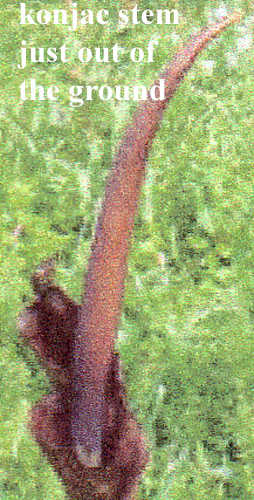 A gelatinous starchy food, konjac is also known as konnyaku; but that is its Japanese name. Often called a yam, though it is not, this two thousand year old Chinese food called ju ruo is in the Amorphollus family. It often has the misleading description of alimentary paste, other names are misleading, too. Called konjaku, devil's taro or devil's tongue, elephant yam, and voodoo lily, to name but a few, these many names may reflect the fact that there are some one hundred species.
A gelatinous starchy food, konjac is also known as konnyaku; but that is its Japanese name. Often called a yam, though it is not, this two thousand year old Chinese food called ju ruo is in the Amorphollus family. It often has the misleading description of alimentary paste, other names are misleading, too. Called konjaku, devil's taro or devil's tongue, elephant yam, and voodoo lily, to name but a few, these many names may reflect the fact that there are some one hundred species.
In China, it is most common in the Sichuan province and commonly cultivated in the Yangzi Valley. There are wild varieties there and everywhere in this country, Japan, Korea, and Indonesia. Before discussing it further, note an important warning, should you come across the wild ones, they can and often do have poisonous plant parts. Therefore, do not forage nor ingest any unknowingly.
When purchasing its cultivated stems (as pictured pushing out of the ground), the main part of the vertical swollen underground plant technically called a tuber and also spoken of as a corm, because a relative is one, this bulbous vegetable, even mistakenly called a bulb should only be purchased raw from sources you know and trust.
Have an edible raw one? Peel, boil, mash, and mix it with a coagulant, the most common is dissolved limestone. This finished product, also known by many names including yam cake, block, brick, gel, and jelly, is usually how we acquire ours, no matter the nomenclature. Fun and easy to work with, in these forms it has little taste and more texture than ordinary gelatin.
Another bit of misinformation about this food item is that it mistakenly is said to have no calories. Truth be told, according to the Food Composition Table for Use in East Asia DHEW Publication No. (NIH) 79-465, one hundred grams of it with nothing added has seventy-two calories as purchased, eighty-one for the edible portion, and thirty-eight milligrams each of calcium and phosphorus, and about four hundred milligrams of potassium.
We like it as noodles, which the Japanese call shirataki or shiru konnyaku when white, and kuro konnyaku when dark with unrefined flour added. Yes, konjac has lots of dietary fiber and mannose and glucose, both sugars, so no wonder it has calories. One common purchased product has mung bean and konjac flours supplemented with fifteen percent white sugar, a little citric acid and a little agar agar. Each manufacturer seems to make theirs a little differently. Asians value it for its ability to cleanse the digestive tract without being a laxative. They love its chewy texture, and often add it to clay-pot and other one-pot dishes.
MAKING KONJAC is done beginning with konkac flour, sometimes called glucomannan powder. It can be found in many organic and vegetarian markets. Not near one, use 'google' or another search engine and try to locate some by one of its many names. Once found, mix one tablespoon of this powder with two cups of water, then boil this for a few minutes before adding one-quarter teaspoon of pickling lime. At that point, bring to the boil again and stir continuously for five minutes. Cool somewhat and pour this into a small container. After a gel forms, it can be steamed as is, cut into noodles, sliced and steamed, or cut up, simmered, or boiled. Any purchased or gelled konjac product can be braised, baked, simmered, or stewed, eaten hot, warm, or cold, as desired. For those who make their own from flour and can not locate limewater, they can make some using one-quarter teaspoon pickling lime stirred into five tablespoons of water. From this, they can measure the amount needed.
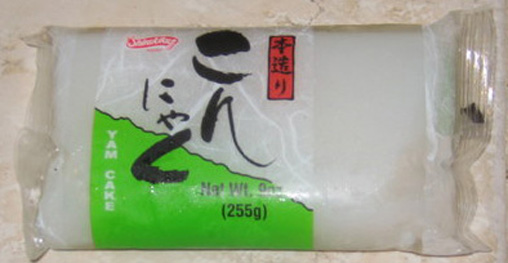
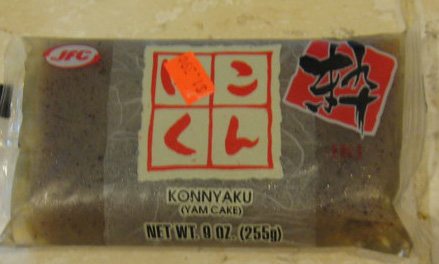 Konjac gel is marketed dark or white, or closer to gray, sometimes with flecks of black, as seen in the brown package on this page. It is also marketed as noodles, in different types of bricks, and as strands. Its primary nutritional component is that high molecular polysaccharide called glucomannan; that is the source of its soluble dietary fiber, and what gives it considerable water-holding capacity.
Konjac gel is marketed dark or white, or closer to gray, sometimes with flecks of black, as seen in the brown package on this page. It is also marketed as noodles, in different types of bricks, and as strands. Its primary nutritional component is that high molecular polysaccharide called glucomannan; that is the source of its soluble dietary fiber, and what gives it considerable water-holding capacity.
Amorphophallis konjac, also known as Amorphophallis rivieri, has almost no fat, unless added when making it into a product. Health-wise, some sources indicate that eating it reduces cholesterol, prevents high blood pressure and diabetes, and keeps excess sugar in check. Very little research we read uses more than a small numbers of subjects, so this aid for controlling weight and cleaning the intestines comes with no guarantees. There is some research in Japanese, for those that read that language, and if looking for it, keep in mind they call it konnyaku. There is also a small amount of research in Korean, and they call it muk. Known to Vegans as 'our gelatin,' this product is firmer than most gelatins, some report a residual taste of seaweed. Wonder if they say that because dried, it can look like agar-agar? Most never sense that taste, nor has that been reported widely.
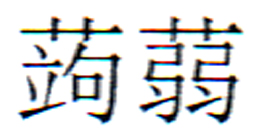
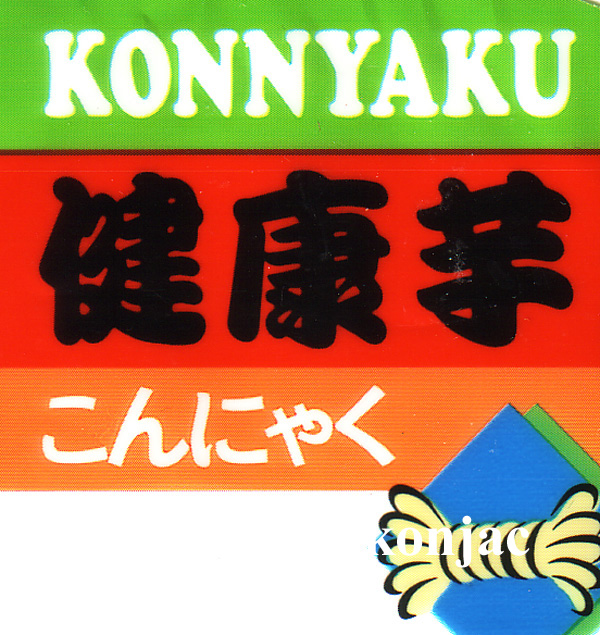 Konjac is sold fresh in various forms and ground into flour. If one wants noodles, purchase the gel blocks and make your own. The small bundles of noodles purchased, as photographed on this page, often have one long noodle wrapped around making a bundle; that is one of the most popular forms in Japan. The Chinese do love it as noodles, but most make their own as we do. They call the noodles mo yu dou fu, sometimes shue mo yu. In the United states, some packaged ones are sold as 'imitation dofu noodles.'
Konjac is sold fresh in various forms and ground into flour. If one wants noodles, purchase the gel blocks and make your own. The small bundles of noodles purchased, as photographed on this page, often have one long noodle wrapped around making a bundle; that is one of the most popular forms in Japan. The Chinese do love it as noodles, but most make their own as we do. They call the noodles mo yu dou fu, sometimes shue mo yu. In the United states, some packaged ones are sold as 'imitation dofu noodles.'
Konjac noodles and blocks of coagulated konjac are found on streets in Chengdu, elsewhere in the Sichuan province, in Beijing, and in Hong Kong at night markets. Vendors make the noodles they sell using a special tool; and they sell theirs commonly topped with a very spicy sauce.
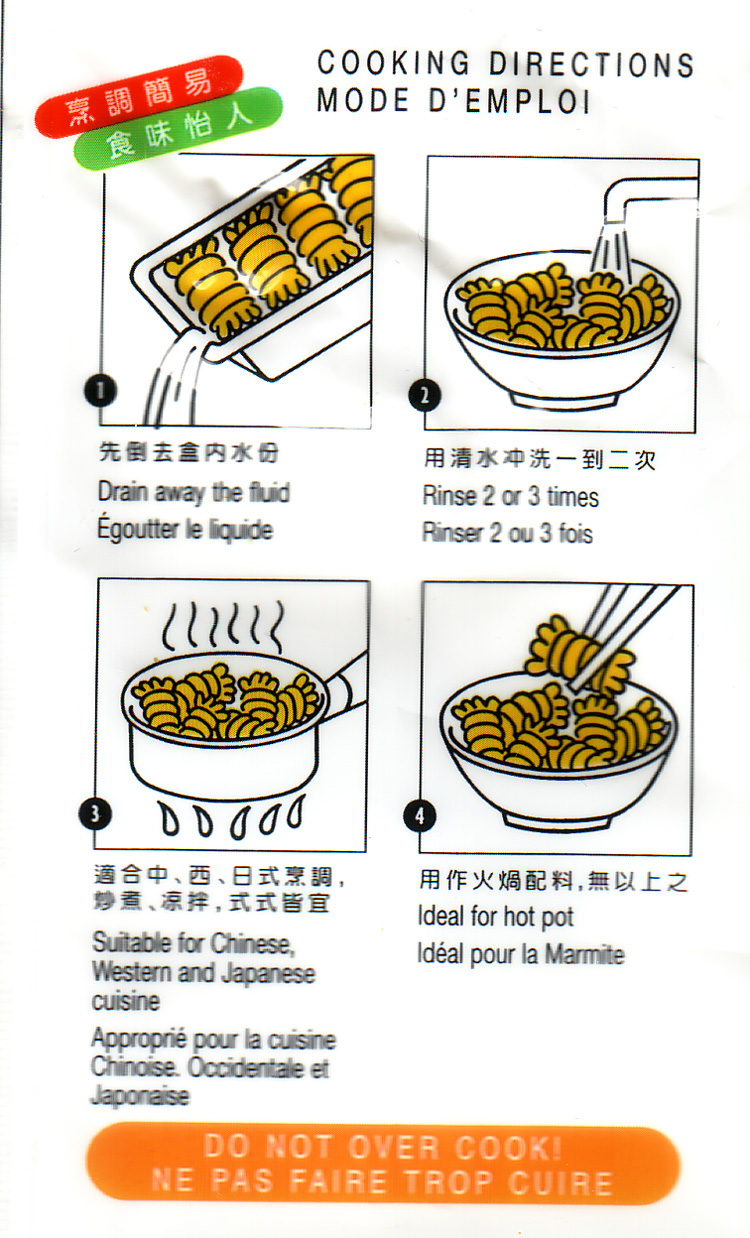 In the mid 1990's, small individual soft plastic cups of candy-type items were sold in large plastic jars that had konjac as an ingredient. These were recalled because a few children choked on the konjac pieces in them. Manufacturers said it was not because they were too small, as regulatory agency folk indicated, but they did change their product. They can now be found in the same large plastic containers, some with a warning about choking. However, we have found none with konjac in them. Now, the whiter pieces in the gelatin is usually cooked coconut soft and suspended in it.
In the mid 1990's, small individual soft plastic cups of candy-type items were sold in large plastic jars that had konjac as an ingredient. These were recalled because a few children choked on the konjac pieces in them. Manufacturers said it was not because they were too small, as regulatory agency folk indicated, but they did change their product. They can now be found in the same large plastic containers, some with a warning about choking. However, we have found none with konjac in them. Now, the whiter pieces in the gelatin is usually cooked coconut soft and suspended in it.
Konjac flour is a good thickener. It is also used when a thin layer is poured and cooled and the resultant sheet is wrapped around non-cooked spring-roll-type foods. Try it in many ways including in soups, stews, and other foods, as noodles or squares, in any shape and any way your dream up. Below are a few simple recipes for your pleasure; try a few or all and then branch out, be creative, and enjoy.
| Hot and Sour Soup, Harbin Style |
|---|
2 cups chicken broth 10 bundles konjac 3 Chinese black mushrooms, soaked, stems discarded, then sliced 1/4 cup crab meat (or shrimp), coarsely chopped 3 Tablespoons Yunnan or another Chinese ham, sliced 1/2 firm bean curd, cut thickness in half, then sliced 1 Tablespoon thin soy sauce 1 Tablespoon black vinegar 1 teaspoon chili paste 1/2 teaspoon sugar 1/4 teaspoon sea or kosher salt 1 Tablespoon cornstarch mixed with two tablespoons cold water dash of ground white pepper 1 egg white 1 teaspoon sesame oil Preparation: 1. Bring Chicken broth to a boil, then add konjac, black mushroom slices, crab meat, ham, bean curd, and the soy sauce. Reduce heat to simmer and cook for three minutes. 2. Add vinegar, chili paste, sugar, salt, cornstarch mixture, and the pepper, and return to the boil, stirring all the time. 3. Turn off the heat, add the egg white and the sesame oil, stir well, and serve in a pre-heated soup tureen or individually in pre-heated soup bowls. |
| Konjac Rolls |
|---|
5 Chinese black mushrooms, soaked, their stems discarded, cut into slices 2 ounces minced cooked meat (beef, pork, or chicken) 1 Tablespoon soy sauce 1 teaspoon sugar 1 Tablespoon sesame oil 3 Tablespoons bamboo shoots, sliced 1 leek, white part only, washed well, then cut into one-inch stick-shaped pieces 1 piece bean curd sheet 2 Tablespoons coarsely minced chives 2 Tablespoons vegetable oil 4 bundles konjac noodles, rinsed and drained and unbundled Preparation: 1. Mix mushrooms, meat, soy sauce, sugar, and sesame oil and let sit for twenty minutes. 2. Add bamboo shoots and leek, and mix again. 3. Cut four- or five-inch squares of bean curd sheet, and place a small batch of the mushroom mixture on it, then add some chives and konjac noodles. Roll into a thick-cigar-shaped roll, and tie with one konjac noodle. 4. Heat wok or fry pan, add oil and fry for two minutes until tan, turn over and fry the other side. Repeat until all are fried, then serve. |
| Konjac Rolls with Sesame Sauce |
|---|
10 konjac rolls 1 sheet seaweed, cut in half then slivered 1 Tablespoon sesame seeds, toasted 1 teaspoon sesame paste 2 Tablespoons hot green tea 1/2 teaspoon granulated sugar 1 teaspoon thin soy sauce 1/2 teaspoon sesame oil Preparation: 1. Put konjac rolls in a large stainer, then pour one cup boiling water over them. Drain well and remove to a flat serving bowl lining them up in two rows. 2. In same strainer, pour one cup boiling water over the seaweed slivers, drain, and dry with paper towels. Spread these over the rolls of konjac. 3. Mix sesame paste and hot green tea until no lumps are left, then add the sugar and the soy sauce, and stir well before stirring in the sesame oil. Pour this over the seaweed and konjac noodles and serve slightly warm or cold. |
| Crab Stick and Turnip Casserole |
|---|
1/4 pound crab sticks, coarsely chopped 1/4 pound white turnip or radish pieces 3 Tablespoons preserved cabbage or pickled mustard green, finely minced 2 stalks Chinese celery, coarsely chopped 2 bundles konjac noodles 1 cup chicken stock Preparation: 1. Put crab, turnip, preserved vegetable and celery pieces into a heat-proof casserole. 2. Loosen two bundles of noodles and cut into one-inch pieces. Mix well with crab mixture. 3. Pour in stock, and place the other noodle bundle on top. Cook over medium heat for fifteen minutes, then serve. |
| Crab, Radish, and Noodle Casserole |
|---|
1 Tablespoon vegetable oil 3 crabs, chopped into six pieces each, the center-body shell of one of them kept whole 3 Tablespoons coarsely chopped napa cabbage 1 stalk Chinese celery, coarsely chopped 1/4 pound large white radish, peeled quartered, and sliced 10 konjac noodles bundles, half of the noodles loosened 1 Tablespoon chicken bouillon 1 Tablespoon thin soy sauce 1 teaspoon oyster sauce Preparation: 1. Heat wok or fry pan and add the oil. Then the crab pieces. Stir-fry for two minutes, then remove and put them in a heat-proof stove-top casserole. 2. Add cabbage, celery, and the radishes to the wok or pan and stir-fry for two minutes, and remove to the same stove-top casserole. 3. Add half cup water, the loosened konjac noodles, chicken bouillon, and the soy and oyster sauces. Cover the casserole and cook on low heat for four minutes, uncover and insert the bundles of konjac noodles. Simmer three minutes more, remove the casserole from the heat and put it on a heat-proof tile on the table. Then serve. |
| Stir-fried Konjac and Vegetables |
|---|
1 Tablespoon vegetable oil 2 cloves garlic, peeled and sliced 1 small onion, shredded or sliced 1 large carrot, peeled and shredded 1 large dried black mushroom, soaked, stem discarded, the cap sliced 4 ounces of konjac, sliced or shredded, as desired 3 ounces bean sprouts, heads and tails removed and discarded is optional 1/4 pound fresh spinach, stems and leaves sliced 1 teaspoon thin soy sauce 1 teaspoon sesame oil Preparation: 1. Heat wok or large fry pan, and add the oil, garlic and onions and stir-fry for one minute or until lightly browned. 2. Add onion, carrot and onion pieces and continue to stir-fry for two minutes, then add the konjac, bean spouts, spinach, soy sauce, and sesame oil and stir-fry one more minute, then serve. |
| Konjac Stew |
|---|
1/2 cup vegetable oil 1 sea bass, red snapper, or carp fish head, gills removed, rinsed and dried with paper towels 1/2 pound firm tofu, sliced into two-inch long thin pieces 4 Chinese black mushrooms, soaked, stems discarded and thinly sliced 3 scallions, cut in half then into one-inch long pieces 4 slices fresh ginger, peeled 1 Tablespoon Chinese rice wine 2 Tablespoons thin soy sauce 1 Tablespoon oyster sauce 1/4 teaspoon mixed ground white, black, and Sichuan pepper 10 bundles of konjac noodles, rinsed under running water Preparation: 1. Heat wok or deep fry pan and add fish head. Fry it turning three or four times until it is brown and crisp, then remove the head and drain it on paper towels. 2. Reheat the oil and fry the tofu slices until tan and crisp, add the mushrooms and fry for another minute, then remove both and drain on paper towels. 3. Discard all but one tablespoon of the oil, reheat it and fry the scallions and ginger for one minute, then return fish head, tofu, and mushrooms and stir once or twice before adding the rice wine, soy sauce, and oyster sauce, the ground pepper, and one quart of boiling water. Reduce the heat to simmer, and cook for fifteen minutes. 4. Add konjac noodle bundles, gently mix them in and simmer for another eight minutes, then serve. |

Copyright © 1994-2024 by ISACC, all rights reserved
Address
3 Jefferson Ferry Drive
S. Setauket NY 11720